Germanium Metasurface for the Polarization-Sensitive Stokes Thermal Imaging at a MWIR 4-Micron Wavelength
Abstract
1. Introduction
2. Design Principle and Simulation
2.1. Material Library, Design Parameter, and Simulation Methodology
2.2. Lattice Resonance to Enhance Transmission
2.3. Circular Polarization (CP) Control with Geometric Phase
3. Simulation Results and Discussion
4. Conclusions
Funding
Institutional Review Board Statement
Data Availability Statement
Conflicts of Interest
References
- Tyo, J.S.; Goldstein, D.L.; Chenault, D.B.; Shaw, J.A. Review of passive imaging polarimetry for remote sensing applications. Appl. Opt. 2006, 45, 5453–5469. [Google Scholar] [CrossRef]
- Carvalho, F.F.; Cruz, C.A.d.M.; Marques, G.C.; Damasceno, K.M.C. Angular Light, Polarization and Stokes Parameters Information in a Hybrid Image Sensor with Division of Focal Plane. Sensors 2020, 20, 3391. [Google Scholar] [CrossRef]
- Pezzaniti, J.L.; Chenault, D.B. A division of aperture MWIR imaging polarimeter. In Polarization Science and Remote Sensing II, Proceedings of the Spie, San Diego, CA, USA, 2–4 August 2005; SPIE: Bellingham, WA, USA, 2005; Volume 5888. [Google Scholar]
- Wu, X.; Huang, H.S.; Peters, K.; Wu, X.; Pankow, M.; Huang, H.S.; Peters, K. High-speed polarization imaging of dynamic collagen fiber realignment in tendon-to-bone insertion region fiber realignment in tendon-to-bone insertion region. J. Biomed Opt. 2018, 23, 1–11. [Google Scholar]
- Harchanko, J.S.; Pezzaniti, L.; Chenault, D.; Eades, G. Comparing a MWIR and LWIR polarimetric imager for surface swimmer detection. In Polarization: Measurement, Analysis, and Remote Sensing VIII, Proceedings of the Spie, 16–20 May 2008; SPIE: Bellingham, WA, USA, 2008; Volume 6945, pp. 194–204. [Google Scholar]
- Ei, S.H.W.; Ang, Z.H.Y. Design of ultracompact polarimeters based on dielectric metasurfaces. Opt. Lett. 2017, 42, 1580–1583. [Google Scholar]
- Rubin, N.A.; D’aversa, G.; Chevalier, P.; Shi, Z.; Chen, W.T.; Capasso, F. Matrix Fourier optics enables a compact full-Stokes polarization camera. Science 2019, 365, eaax1839. [Google Scholar] [CrossRef]
- Zaidi, A.; Rubin, N.A.; Meretska, M.L.; Li, L.W.; Dorrah, A.H.; Park, J.-S.; Capasso, F. Metasurface-enabled single-shot and complete Mueller matrix imaging. Nat. Photonics 2024, 18, 704–712. [Google Scholar] [CrossRef]
- Rubin, N.A.; Chevalier, P.; Juhl, M.; Tamagnone, M.; Chipman, R.; Capasso, F. Imaging polarimetry through metasurface polarization gratings. Opt. Express 2022, 30, 9389–9412. [Google Scholar] [CrossRef]
- Fan, Q.; Xu, W.; Hu, X.; Zhu, W.; Yue, T.; Yan, F.; Lin, P.; Chen, L.; Song, J.; Lezec, H.J.; et al. Disordered metasurface enabled single-shot full-Stokes polarization imaging leveraging weak dichroism. Nat. Commun. 2023, 14, 7180. [Google Scholar] [CrossRef]
- Karakasoglu, I.; Xiao, M.; Fan, S. Polarization control with dielectric helix metasurfaces and arrays. Opt. Express 2018, 26, 21664–21674. [Google Scholar] [CrossRef]
- Yang, B.; Liu, W.; Li, Z.; Cheng, H.; Chen, S.; Tian, J. Polarization-Sensitive Structural Colors with Hue-and-Saturation Tuning Based on All-Dielectric Nanopixels. Adv. Opt. Mater. 2018, 6, 1–8. [Google Scholar] [CrossRef]
- Zhang, L.; Chen, X.Q.; Liu, S.; Zhang, Q.; Zhao, J.; Dai, J.Y.; Bai, G.D.; Wan, X.; Cheng, Q.; Castaldi, G.; et al. Space-time-coding digital metasurfaces. Nat. Commun. 2018, 9, 4334. [Google Scholar] [CrossRef]
- Fu, Y.; Min, C.; Yu, J.; Xie, Z.; Si, G.; Wang, X.; Zhang, Y.; Lei, T.; Lin, J.; Wang, D.; et al. Measuring phase and polarization singularities of light using spin-multiplexing metasurfaces. Nanoscale 2019, 11, 18303–18310. [Google Scholar] [CrossRef]
- Cao, W.; Yang, X.; Gao, J. Broadband polarization conversion with anisotropic plasmonic metasurfaces. Sci. Rep. 2017, 7, 8841. [Google Scholar] [CrossRef]
- Zhang, K.; Wang, Y.; Yuan, Y.; Burokur, S.N. A Review of Orbital Angular Momentum Vortex Beams Generation: From Traditional Methods to Metasurfaces. Appl. Sci. 2020, 10, 1015. [Google Scholar] [CrossRef]
- Overvig, A.C.; Shrestha, S.; Malek, S.C.; Lu, M.; Stein, A.; Zheng, C.; Yu, N. Dielectric metasurfaces for complete and independent control of the optical amplitude and phase. Light Sci. Appl. 2019, 8, 92. [Google Scholar] [CrossRef]
- Ou, K.; Yu, F.; Li, G.; Wang, W.; Miroshnichenko, A.E.; Huang, L.; Wang, P.; Li, T.; Li, Z.; Chen, X.; et al. Mid-infrared polarization-controlled broadband achromatic metadevice. Sci. Adv. 2020, 6, eabc0711. [Google Scholar] [CrossRef]
- Tong, L.; Huang, X.; Wang, P.; Ye, L.; Peng, M.; An, L.; Sun, Q.; Zhang, Y.; Yang, G.; Li, Z.; et al. Stable mid-infrared polarization imaging based on quasi-2D tellurium at room temperature. Nat. Commun. 2020, 11, 2308. [Google Scholar] [CrossRef]
- Zou, H.; Nash, G.R. Efficient mid-infrared linear-to-circular polarization conversion using a nanorod-based metasurface. Opt. Mater. Express 2022, 12, 4565–4573. [Google Scholar] [CrossRef]
- Dai, M.; Wang, C.; Qiang, B.; Wang, F.; Ye, M.; Han, S.; Luo, Y.; Wang, Q.J. On-chip mid-infrared photothermoelectric detectors for full-Stokes detection. Nat. Commun. 2022, 13, 4560. [Google Scholar] [CrossRef]
- Yan, C.; Li, X.; Pu, M.; Ma, X.; Zhang, F.; Gao, P.; Liu, K.; Luo, X. Midinfrared real-time polarization imaging with all-dielectric metasurfaces. Appl. Phys. Lett. 2019, 114, 161904. [Google Scholar] [CrossRef]
- Chen, J.; Yu, F.; Liu, X.; Bao, Y.; Chen, R.; Zhao, Z.; Wang, J.; Wang, X.; Liu, W.; Shi, Y.; et al. Polychromatic full-polarization control in mid-infrared light. Light. Sci. Appl. 2023, 12, 105. [Google Scholar] [CrossRef]
- Zhang, Y.; Pu, M.; Jin, J.; Lu, X.; Guo, Y.; Cai, J.; Zhang, F.; Ha, Y.; He, Q.; Xu, M.; et al. Crosstalk-free achromatic full Stokes imaging polarimetry metasurface enabled by polarization-dependent phase optimization. Opto-Electron. Adv. 2022, 5, 220058. [Google Scholar] [CrossRef]
- Yin, Z.; Chen, F.; Zhu, L.; Guo, K.; Shen, F.; Zhou, Q.; Guo, Z. High-efficiency dielectric metasurfaces for simultaneously engineering polarization and wavefront. J. Mater. Chem. C 2018, 6, 6354–6359. [Google Scholar] [CrossRef]
- Guo, K.; Li, X.; Ai, H.; Ding, X.; Wang, L.; Wang, W.; Guo, Z. Tunable oriented mid-infrared wave based on metasurface with phase change material of GST. Results Phys. 2022, 34, 105269. [Google Scholar] [CrossRef]
- Arcia, M.I.G.; Dmiston, C.H.E.; Arinov, R.A.M.; Ail, A.L.V.; Ruev, V.I.G. Bio-inspired color-polarization imager for real-time in situ imaging. Optica 2017, 4, 1263–1271. [Google Scholar]
- Kastek, M.; Piątkowski, T.; Polakowski, H.; Barela, J.; Firmanty, K.; Trzaskawka, P.; Vergara, G.; Linares, R.; Gutierrez, R.; Fernandez, C.; et al. Technology of uncooled fast polycrystalline PbSe focal plane arrays in systems for muzzle flash detection. In Proceedings of the SPIE Defense + Security, 2014, Baltimore, MD, USA, 29 May 2014. [Google Scholar] [CrossRef]
- Sultana, H. Periodicity and Lattice Resonance: Transmission Control of the High Contrast Dielectric Metasurface. In Frontiers in Optics + Laser Science 2022 (FIO, LS); Optica Publishing Group: Washington, DC, USA, 2022; p. JW4B.69. [Google Scholar]
- Shen, S.; Ruan, Z.; Li, S.; Yuan, Y.; Tan, H. The influence of periodicity on the optical response of cube silicon metasurfaces. Results Phys. 2021, 23, 104057. [Google Scholar] [CrossRef]
- Babicheva, V.E.; Evlyukhin, A.B. Resonant Lattice Kerker Effect in Metasurfaces with Electric and Magnetic Optical Responses. Laser Photon Rev. 2017, 11, 1700132. [Google Scholar] [CrossRef]
- Kerker, M.; Wang, D.-S.; Giles, C.L. Electromagnetic scattering by magnetic spheres. J. Opt. Soc. Am. 1983, 73, 765–767. [Google Scholar] [CrossRef]
- Fu, Y.H.; Kuznetsov, A.I.; Miroshnichenko, A.E.; Yu, Y.F.; Luk’yanchuk, B. Directional visible light scattering by silicon nanoparticles. Nat. Commun. 2013, 4, 1527. [Google Scholar] [CrossRef] [PubMed]
- Evlyukhin, A.B.; Reinhardt, C.; Seidel, A.; Luk’yanchuk, B.S.; Chichkov, B.N. Optical response features of Si-nanoparticle arrays. Phys. Rev. B 2010, 82, 45404. [Google Scholar] [CrossRef]
- Castellanos, G.W.; Bai, P.; Rivas, J.G. Lattice resonances in dielectric metasurfaces. J. Appl. Phys. 2019, 125, 213105. [Google Scholar] [CrossRef]
- Babicheva, V.E.; Moloney, J.V. Lattice effect influence on the electric and magnetic dipole resonance overlap in a disk array. Nanophotonics 2018, 7, 1663–1668. [Google Scholar] [CrossRef]
- Tsoi, S.; Bezares, F.J.; Giles, A.; Long, J.P.; Glembocki, O.J.; Caldwell, J.D.; Owrutsky, J. Experimental demonstration of the optical lattice resonance in arrays of Si nanoresonators. Appl. Phys. Lett. 2016, 108, 111101. [Google Scholar] [CrossRef]
- Yu, N.; Genevet, P.; Kats, M.A.; Aieta, F.; Tetienne, J.P.; Capasso, F.; Gaburro, Z. Light Propagation with Phase Reflection and Refraction. Science 2011, 334, 333–337. [Google Scholar] [CrossRef] [PubMed]
- Sultana, H. Coupled Plasmon Wave Dynamics beyond Anomalous Reflection: A Phase Gradient Copper Metasurface for the Visible to Near-Infrared Spectrum. Optics 2022, 3, 243–253. [Google Scholar] [CrossRef]
- Ding, F.; Tang, S.; Bozhevolnyi, S.I. Recent Advances in Polarization-Encoded Optical Metasurfaces. Adv. Photon. Res. 2021, 2, 2000173. [Google Scholar] [CrossRef]
- Mueller, J.P.B.; Rubin, N.A.; Devlin, R.C.; Groever, B.; Capasso, F. Metasurface Polarization Optics: Independent Phase Control of Arbitrary Orthogonal States of Polarization. Phys. Rev. Lett. 2017, 118, 113901. [Google Scholar] [CrossRef] [PubMed]
- Wen, D.; Yue, F.; Kumar, S.; Ma, Y.; Chen, M.; Ren, X.; Kremer, P.E.; Gerardot, B.D.; Taghizadeh, M.R.; Buller, G.S.; et al. Metasurface for characterization of the polarization state of light. Opt. Express 2015, 23, 10272–10281. [Google Scholar] [CrossRef]
- Kang, M.; Feng, T.; Wang, H.-T.; Li, J. Wave front engineering from an array of thin aperture antennas. Opt. Express 2012, 20, 15882–15890. [Google Scholar] [CrossRef]
- Chen, Y.-C.; Zeng, Q.-C.; Yu, C.-Y.; Wang, C.-M. General case of the overall phase modulation through a dielectric PB-phase metasurface. OSA Contin. 2021, 4, 3204–3212. [Google Scholar] [CrossRef]
- Sultana, H.; Weng, B. Implementing the Geometric Phase for Designing the Axially Asymmetric Metasurface Element. In CLEO 2024; Technical Digest Series; Optica Publishing Group: Washington, DC, USA, 2024; p. JTu2A.164. [Google Scholar]
- Arbabi, E.; Kamali, S.M.; Arbabi, A.; Faraon, A. Full-Stokes Imaging Polarimetry Using Dielectric Metasurfaces. ACS Photonics 2018, 5, 3132–3140. [Google Scholar] [CrossRef]
- Hu, Y.; Wang, X.; Luo, X.; Ou, X.; Li, L.; Chen, Y.; Yang, P.; Wang, S.; Duan, H. All-dielectric metasurfaces for polarization manipulation: Principles and emerging applications. Nanophotonics 2020, 9, 3755–3780. [Google Scholar] [CrossRef]
- Hsiao, H.; Chu, C.H.; Tsai, D.P. Fundamentals and Applications of Metasurfaces. Small Methods 2017, 1, 1600064. [Google Scholar] [CrossRef]
- Zhang, J.; Zeng, J.; Liu, Y.; Dong, Y.; Wang, J. Fundamental challenges induced by phase modulation inaccuracy and optimization guidelines of geometric phase metasurfaces with broken rotation symmetry. Opt. Express 2021, 29, 34314. [Google Scholar] [CrossRef] [PubMed]
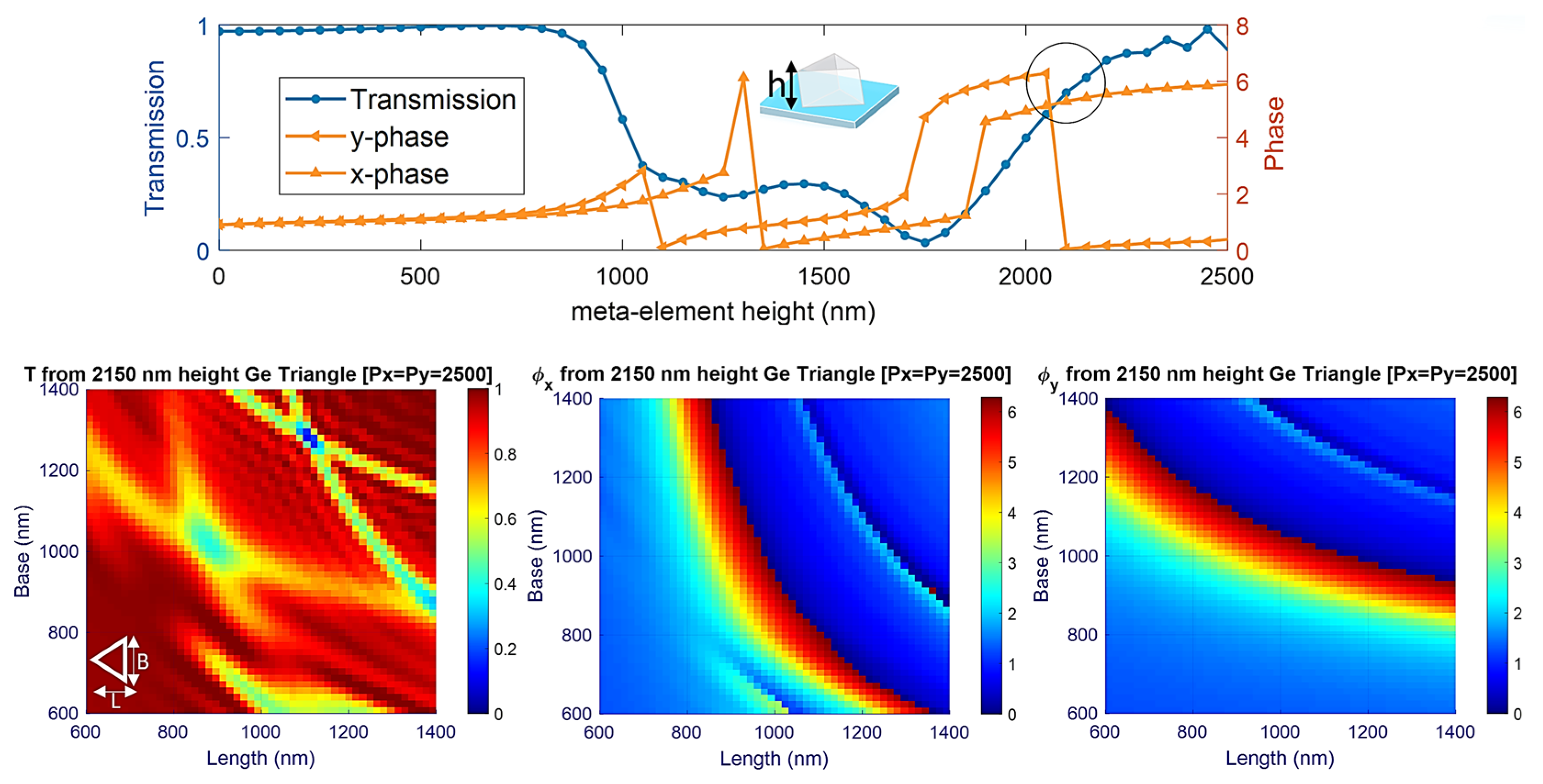
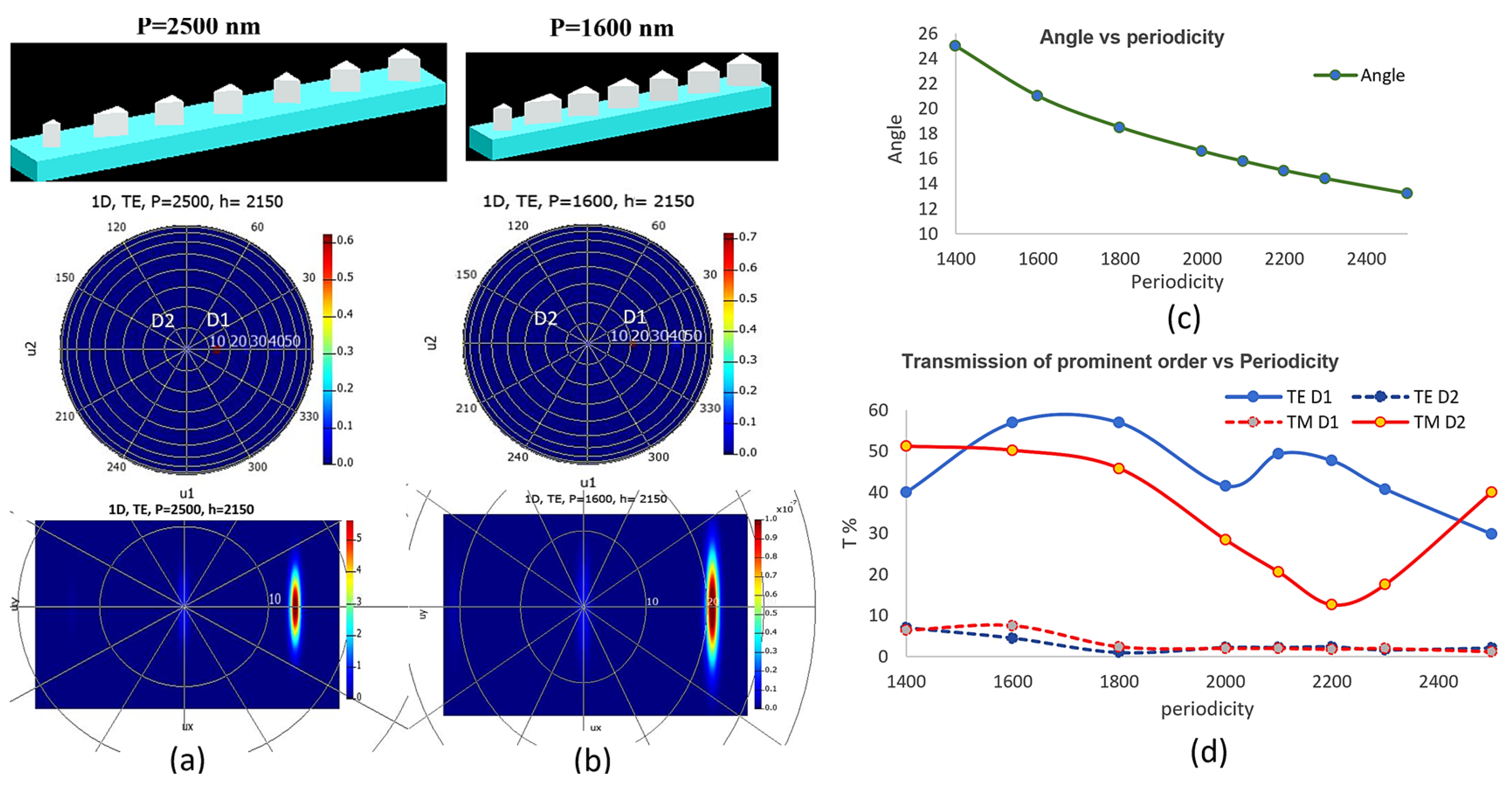
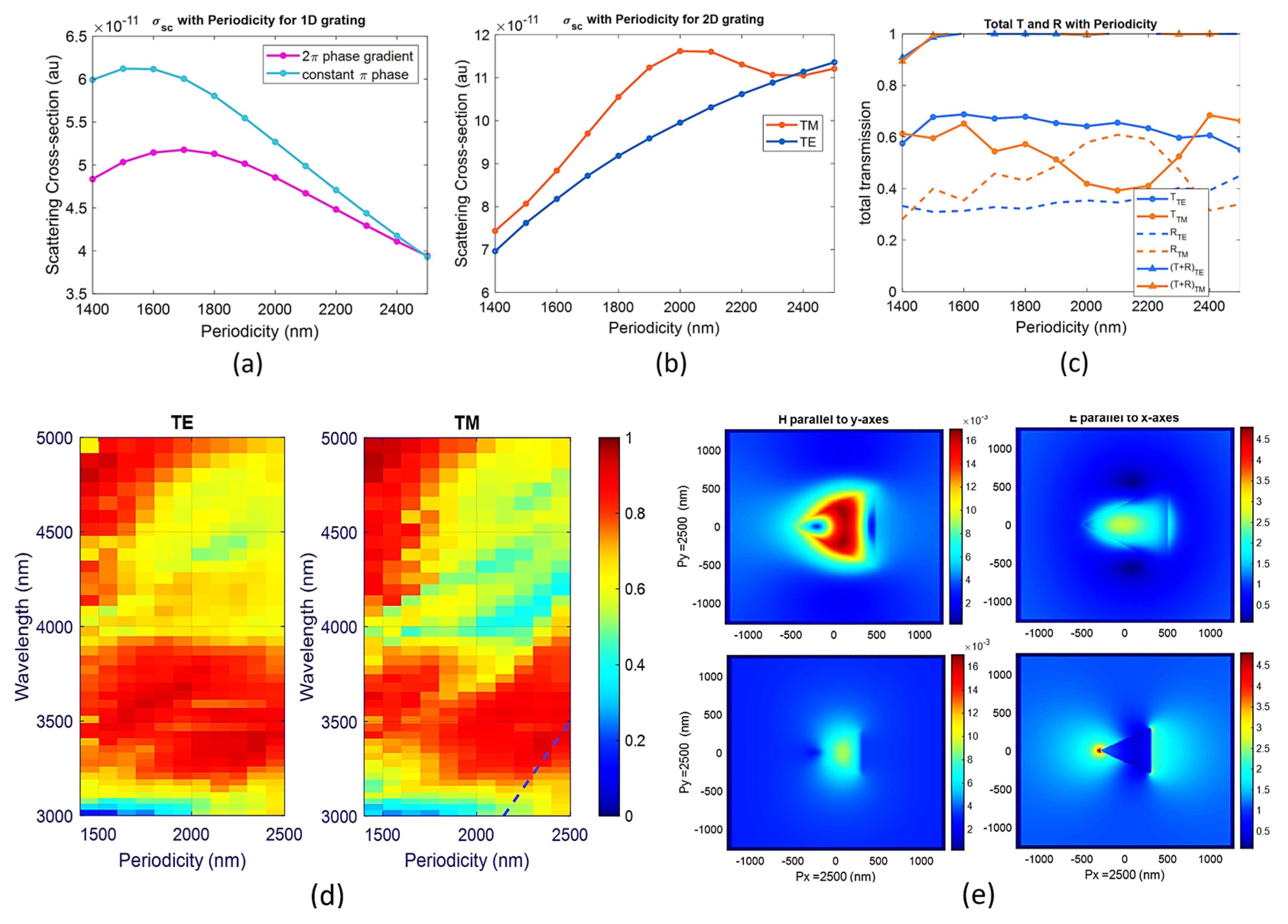
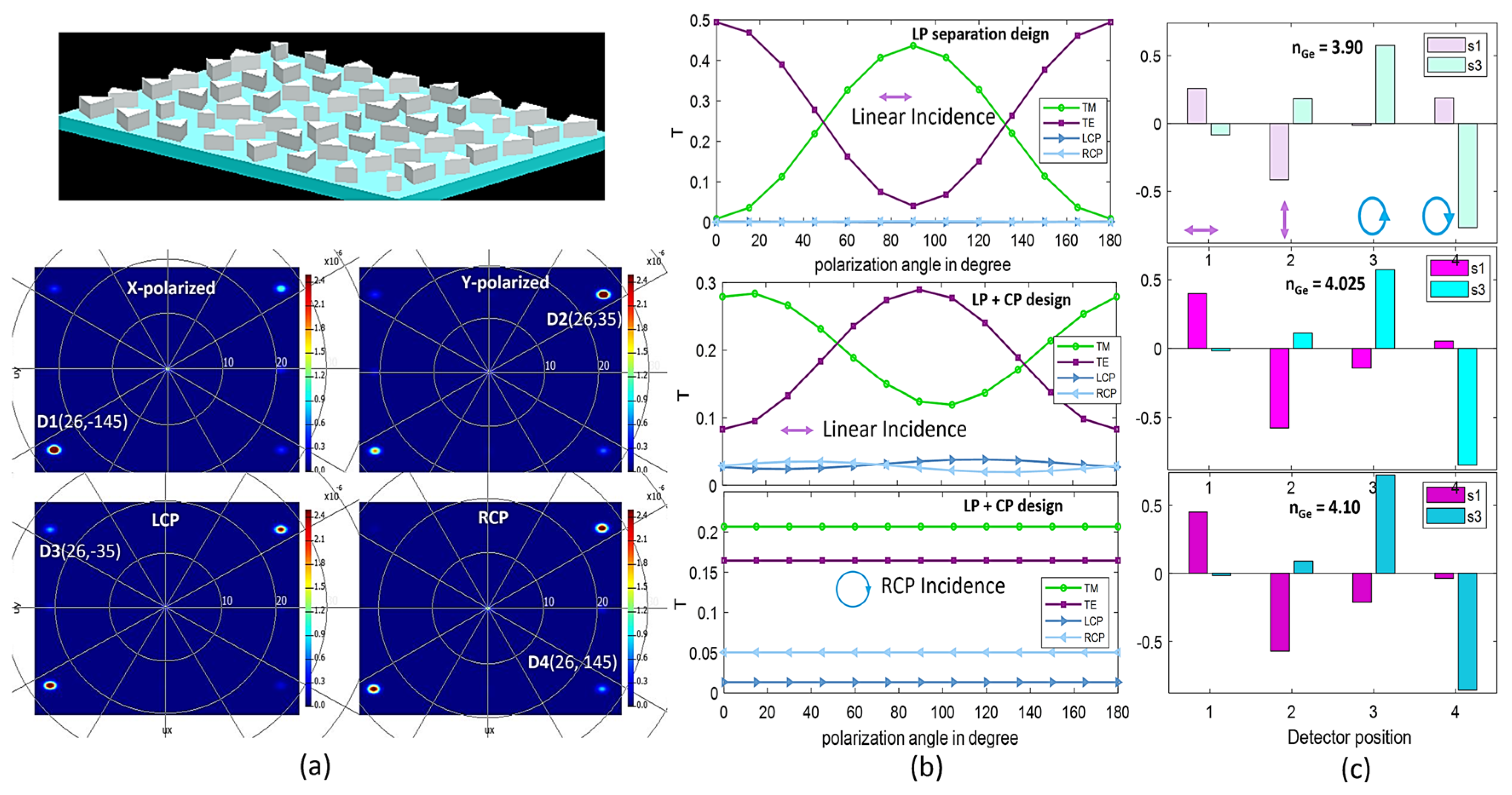
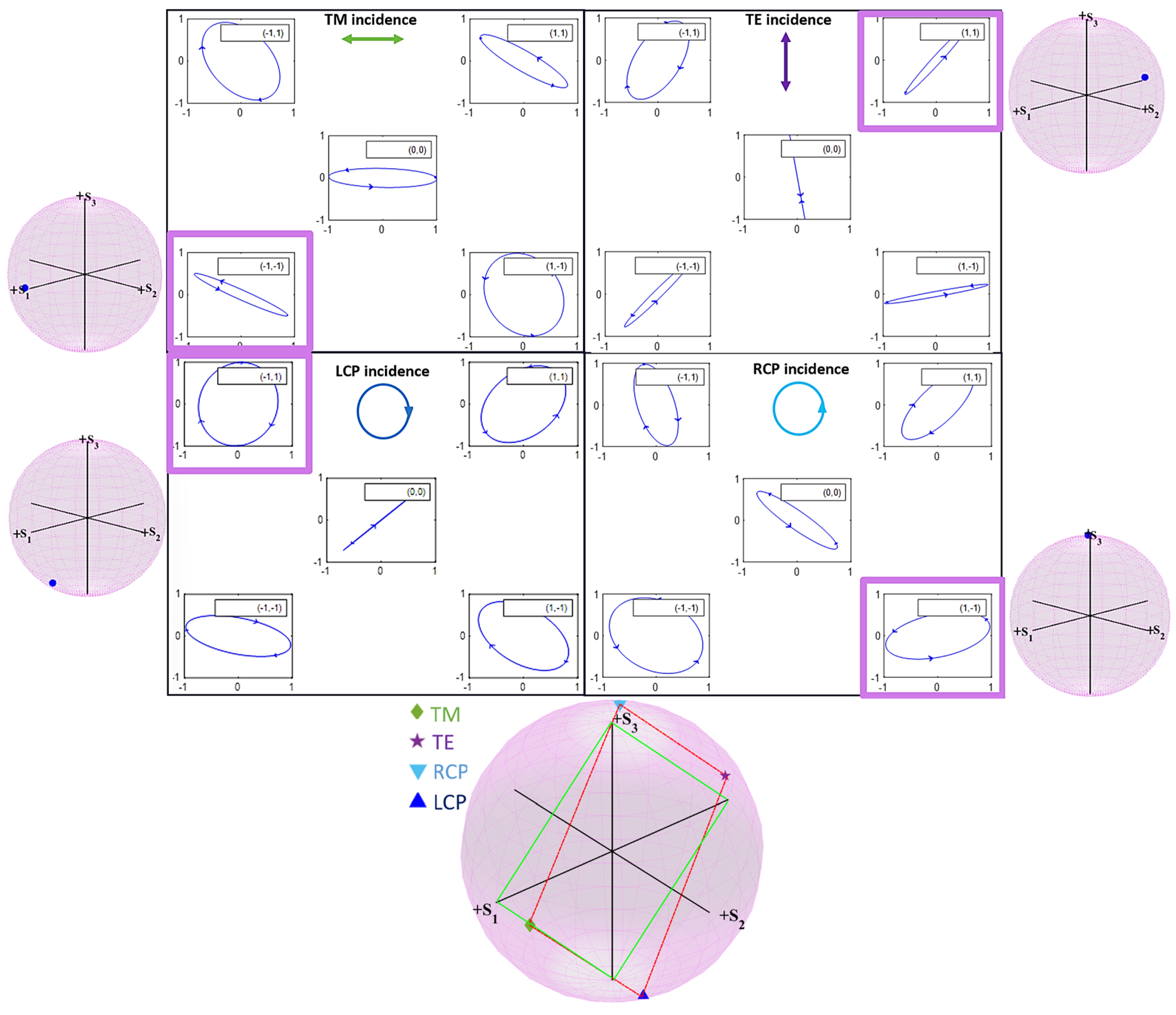
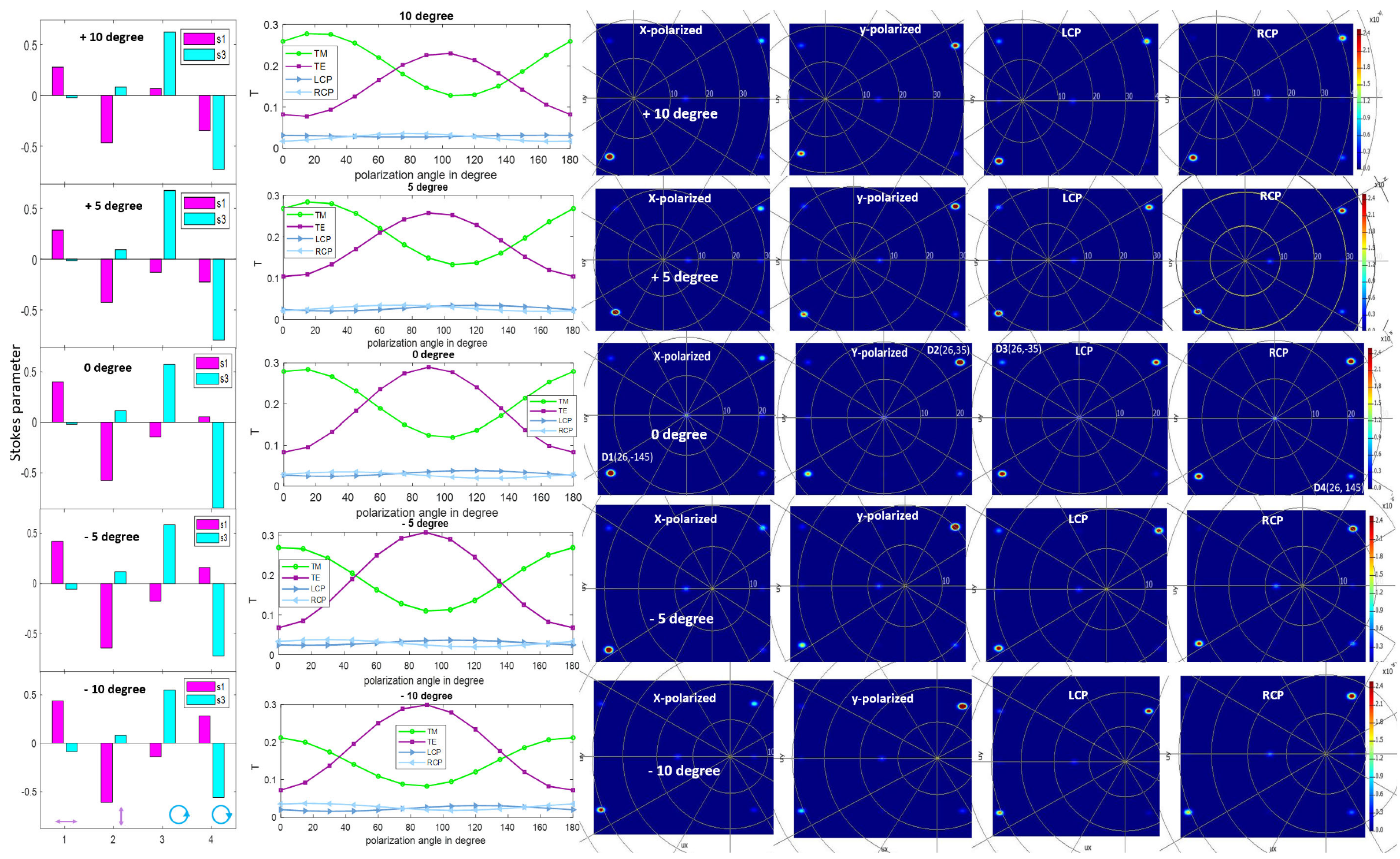
Disclaimer/Publisher’s Note: The statements, opinions and data contained in all publications are solely those of the individual author(s) and contributor(s) and not of MDPI and/or the editor(s). MDPI and/or the editor(s) disclaim responsibility for any injury to people or property resulting from any ideas, methods, instructions or products referred to in the content. |
© 2025 by the author. Licensee MDPI, Basel, Switzerland. This article is an open access article distributed under the terms and conditions of the Creative Commons Attribution (CC BY) license (https://creativecommons.org/licenses/by/4.0/).
Share and Cite
Sultana, H. Germanium Metasurface for the Polarization-Sensitive Stokes Thermal Imaging at a MWIR 4-Micron Wavelength. Photonics 2025, 12, 137. https://doi.org/10.3390/photonics12020137
Sultana H. Germanium Metasurface for the Polarization-Sensitive Stokes Thermal Imaging at a MWIR 4-Micron Wavelength. Photonics. 2025; 12(2):137. https://doi.org/10.3390/photonics12020137
Chicago/Turabian StyleSultana, Hosna. 2025. "Germanium Metasurface for the Polarization-Sensitive Stokes Thermal Imaging at a MWIR 4-Micron Wavelength" Photonics 12, no. 2: 137. https://doi.org/10.3390/photonics12020137
APA StyleSultana, H. (2025). Germanium Metasurface for the Polarization-Sensitive Stokes Thermal Imaging at a MWIR 4-Micron Wavelength. Photonics, 12(2), 137. https://doi.org/10.3390/photonics12020137




